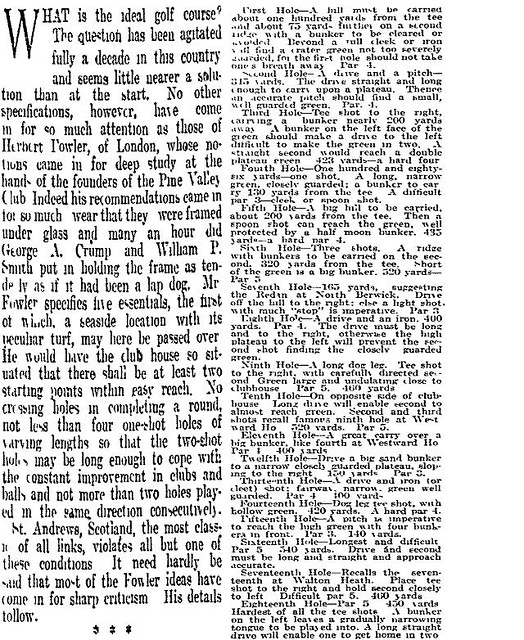A couple of nuggets to discuss:
1. When Oakmont opened it had 8 par 5's and a par 6 for a total par of 80. Perhaps Fownes foresaw some of those holes evolving into long par 4's with the advent of the new ball, but perhaps he just had a preference for par 5 holes. There were longer courses in existence on an average distance per shot basis.
2. Any discussion of the holes being laid out scientifically can only refer to the hole lengths, as the bunkers were laid out at a later date.
3. By all accounts, Fownes had a plan in mind prior to actually finding and purchasing the land for the course. Yet there is still discussion that he worked with the natural landforms. Sounds to me like the course was crafted, rather than found, and that the talk of naturalism is a bit misplaced.
Sven,
Really interesting article, thanks again.
To your points;
1) The 80 wasn't the par at Oakmont, it was the "Bogey Score", although with scores of 90 shot by both H.C. Fownes and George Ormiston on Opening Day, even that may have been a bit low.
2) Completely agree, and I've been taken to task by everyone from Bob Crosby to Melvyn Morrow regarding usage of "scientific" so I must be wrong. I think you're correct that what the term means in the Oakmont origin articles I posted was a very purposeful intent to create golf holes requiring certain clubs to be played, sort of an early "every club in the bag" with an emphasis on the longer ones. In fact, the articles Joe and I posted say almost exactly that, vis a vis
"The golf course was developed with the best standards, having been laid out scientifically with the purpose of making every hole perfect as far as the number of shots is concerned."3) I'm not sure if you've been to Oakmont Sven, but I think you'd find it far from crafted, particularly in terms of locations of green sites. And I'm not sure that there is much validity to the assertion that having an overall plan for lengths and balances of golf holes on a course is limited by much but total overall acreage. For instance, George Crump knew very clearly what balance and lengths of golf holes he wanted for his "ideal course" at Pine Valley, even if he didn't know exactly where each would be located. Similarly, CB Macdonald pretty much knew a lot of the ideal template holes he wanted to place at NGLA, although arguably in some cases like the Road Hole he did craft them a bit to get the desired imitative result. Macdonald also provided Merion with an ideal balance of holes for their purposes which they seem to have followed loosely, although they extended a bit beyond his recommended "6,000 yard" course. I don't think any of those cases led to a course that wouldn't be described as utilizing natural features.
Finally, a question for you. What is the first course chronologically that you're familiar with where it was purposefully built without any (or very few) bunkers with the intention that they would be added later after actual play was carefully observed? Thanks!
Here's a related article you may find of interest;
